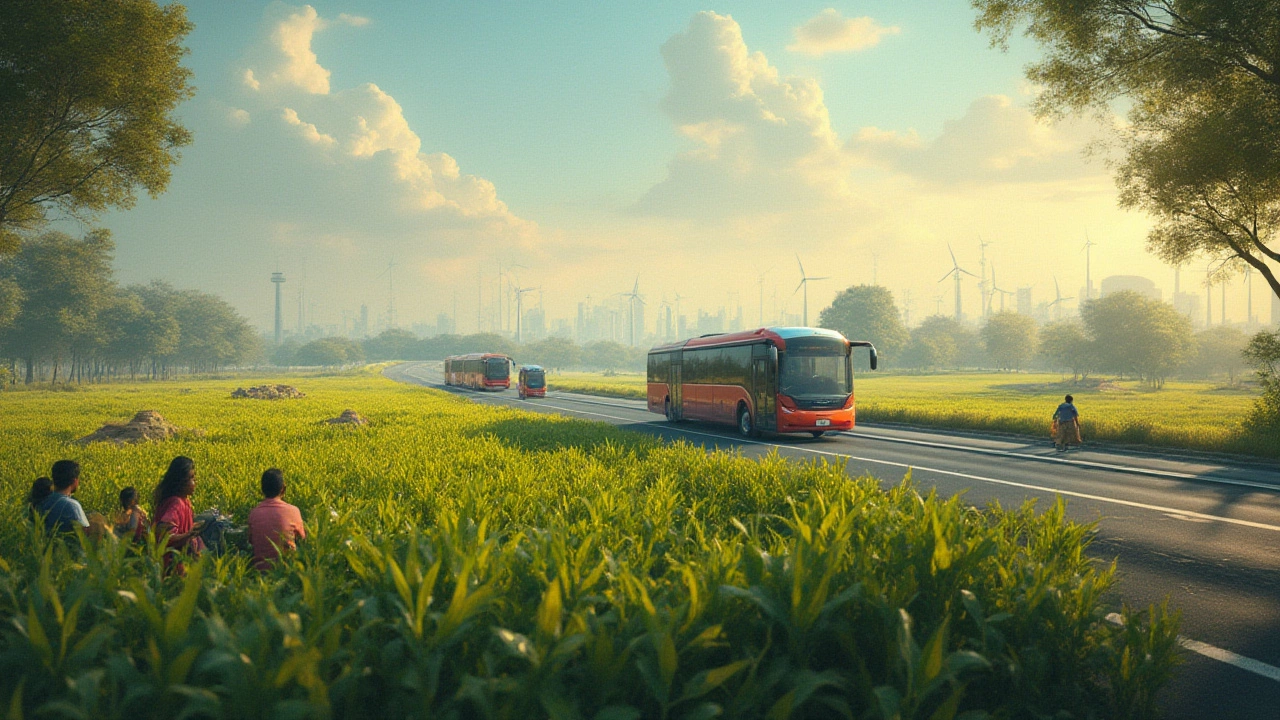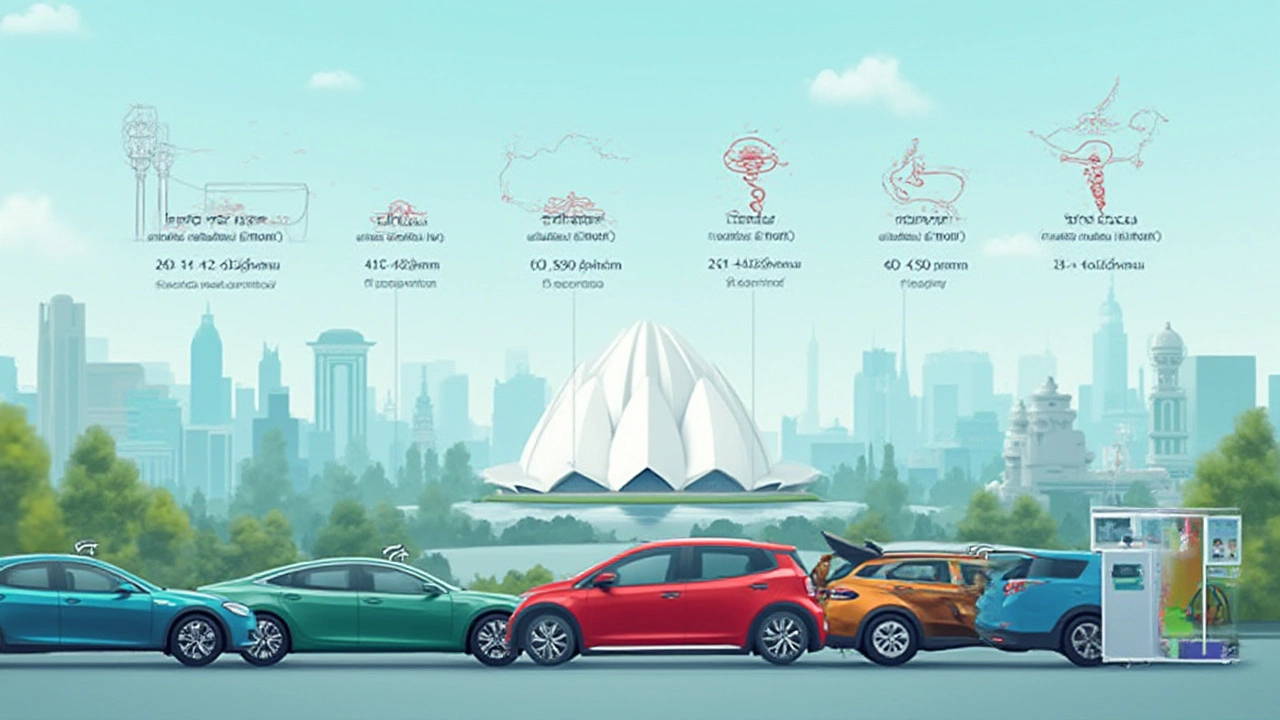Best Renewable Energy Sources to Replace Gasoline in Cars
 Jul, 21 2025
Jul, 21 2025
Walk down a busy Liverpool street, and you can actually taste the exhaust sometimes. It’s wild to think that this is still so normal in 2025—even when cleaner ways to power cars are buzzing in and out of the news every day. The smog, the cost, the carbon footprint—gasoline just feels outdated. But which renewable energy source is really ready to take its place under the hood and actually work for everyone?
The Case for Electric Cars and Battery Power
The first thing to pop into most people’s minds is the electric car. Tesla, Nissan Leaf, Volkswagens, even my neighbor with his used Kia—these cars seem to be everywhere lately. It’s not just hype: as of April 2025, global electric car sales jumped above 16 million annually, and the UK now has roughly one electric car per every six on the road. The big deal here is batteries. Lithium-ion batteries are leading the charge (pun intended), but newer chemistries—like solid-state—promise more range, faster charging, and less risk of that whole battery-fire thing that freaked people out a few years back.
Plugging in at home is cheaper than filling up at the station. There’s a growing network of public chargers, with the UK hitting over 90,000 publicly accessible charge points this spring. For context, London’s got more high-speed chargers now than petrol stations. That’s a massive shift. On the emissions side, if the electricity comes from renewables (solar, wind, hydropower), you’re basically driving a zero-tailpipe-emissions vehicle. Sure, making batteries isn’t squeaky clean—there’s still mining, shipping, and recycling headaches—but the total carbon footprint is way smaller than burning petrol every day.
This is where things get really interesting. Between 2010 and 2024, the cost to build a kilowatt-hour of battery storage dropped by 85%. It’s what made electric cars go from luxury weird gadgets to almost mainstream in just a decade. And now, the next leap is on the horizon: sodium-ion and even lithium-sulfur batteries. They use more common materials, so future supply problems could fade. Driving range anxiety is also fading as newer cars easily go 400+ kilometers on a charge.
But there are headaches. Charging still takes longer than a gas fill-up, especially if you’re not using a super-fast charger. The batteries don’t love sub-zero Liverpool winters, either. And some rural spots—funnily enough, near where I take my dog Whiskers hiking—are charger dead zones. Still, electric cars are miles ahead of other renewables. The tech is reliable, governments are throwing money at fast charging networks, and practically every carmaker has announced they’ll go all-electric by 2030 or soon after.
The Promise—and Hurdles—of Hydrogen Fuel
Hydrogen cars sound almost too futuristic: just fill up with hydrogen, and the car emits nothing but water vapor. No carbon monoxide, no particulates, just clean air out the tailpipe. It’s the darling of engineers who love the elegance of the science. Toyota, Hyundai, and Honda actually sell hydrogen fuel cell cars right now. And the UK government sees hydrogen as a serious contender for freight trucks, buses, trains, and even ferries. The North West Hydrogen Cluster is investing millions to make this a reality up near Liverpool and Manchester.
Hydrogen is cool because you can make it in lots of ways. The greenest method? Electrolysis using renewable energy—basically, splitting water into hydrogen and oxygen using nothing but sun, wind, or hydro power. That’s how you get “green hydrogen.” There’s some not-so-green hydrogen, too, which sneaks in a carbon footprint and isn’t much better than gasoline. So, it’s all about how the hydrogen is produced.
The uphill battle? Infrastructure. There are just 13 public hydrogen fueling stations in all of the UK as of July 2025. You can drive all over Liverpool and not see a single one—unless you happen to work at a bus depot. Building a whole new fueling network is expensive. Plus, making, compressing, and trucking hydrogen to stations eats energy. Some energy experts say you use almost as much power creating hydrogen as you get out of burning it. The science-y term for this is 'round-trip efficiency,' and for hydrogen it isn’t winning medals yet.
Here’s the kicker: hydrogen cars can fill up in roughly the same time as petrol ones—about 5 minutes. That’s perfect for big fleets (like delivery vans or city buses) where downtime isn’t an option. But for your average driver, lack of stations and high costs keep hydrogen in the slow lane. Technology could change this totally in the next decade—especially with investment ramping up in the EU, US, Japan, and China—but for 2025, hydrogen is mostly for specialty vehicles and experiments, not the family car.
| Energy Source | Efficiency (%) | UK Charge Points/Stations (2025) | Major Producers |
|---|---|---|---|
| Electricity (Battery) | 70-90 | 90,000+ | Tesla, Nissan, VW |
| Hydrogen | 20-25 | 13 | Toyota, Hyundai, Honda |
| Biofuels | 30-40 | 580 | Various |

Could Biofuels Replace Gasoline?
So, what about fueling up with something made from plants? Biofuels sound simple enough—you can use crops like maize, sugarcane, even used chip frying oil—turn it into ethanol or biodiesel, put it in a regular engine, and drive off. The appeal is obvious: less new carbon dioxide, more recycling, and you barely need to change the car, especially if you’ve got a diesel already humming along.
In Europe, bioethanol and biodiesel are mixed into regular gasoline at the pump. Most petrol stations around Liverpool have E10 petrol—that’s 10% plant-based ethanol. You probably use biofuels already, and don’t even notice. There’s even talk of E85, with 85% ethanol, in Sweden and Brazil, where engines are designed for it. The upfront costs are lower and the switch feels smooth for drivers. In 2024, the UK produced over 950 million liters of biofuel, with most of that going into cars and trucks.
But size matters, literally. You can’t make enough biofuel without using tons of farmland. And when you need land to feed people (and dogs like Whiskers), energy crops can push up food prices. Some biofuels, called advanced or second-gen biofuels, use stuff we’d throw away—like agri waste, wood chips, or even algae. Those are way smarter, but making enough to keep up with demand is a struggle. Then there’s the CO2 math—all the plowing, planting, harvesting, and processing eats energy. Depending on whom you ask, the footprint of some biofuels isn’t a lot cleaner than petrol, especially when crops replace forests.
Still, biofuels fit perfectly for planes, ships, and heavy machinery—places batteries can’t hack it yet. For ordinary cars, biofuels will probably keep playing a backup role, blended into regular petrol and diesel, not as a solo star.
Why Solar, Wind, and Other Options Lag Behind for Cars
I once hoped my first car would run on sunlight alone. Turns out, physics had other ideas. Slapping solar panels on a car roof barely makes a dent in the juice you need—most panels only power a fan or maybe an air freshener, not actual driving. Even the best solar-powered car in the 2023 World Solar Challenge barely managed 1,500 miles across Australia—at an average speed that’d annoy Scousers stuck behind it. Direct solar cars are a no-go for Liverpool weather, trust me!
What solar and wind do best is power the grid. That’s where things get interesting: as the UK grid heads toward 60% renewable-powered (stats from this April), charging your electric car mostly with wind or solar juice gets cleaner every year. Tidal and wave energy are making ripples—Scotland leads the world in tidal turbines, and they could one day top up the grid, but it’s way too early to expect a wave-powered Mini Cooper.
Geothermal energy is brilliant for heating homes in Iceland, but doesn’t work for transport at scale outside volcanic hotspots. Even nuclear, for all its low carbon perks, just isn’t flexible or cheap enough to make a dent in car power.
So, next time you see a solar panel-topped car at a green fair, remember: the real action is behind the scenes, where wind turbines and solar farms charge up massive battery banks, and then you plug your car into that clean grid back home.

What’s Next: The Future of Renewables as Car Fuel
If you ask around, which renewable energy source could truly replace gasoline for most people’s cars? Right now, electric vehicles are already out of the starting gate—leading on cost, numbers, availability, and climate impact. Hydrogen shines in heavy-duty uses and could catch up with the right investments, but until UK drivers see hydrogen pumps as common as Greggs shops, that day’s a long way off. Biofuels, while clever, seem best as support acts for trucks, planes, or rural uses, not the everyday ride to Anfield or work.
The top tip for anyone eyeing a car change? Check the electricity mix where you live. If there’s loads of wind or solar, owning an EV is an instant climate win. Some UK councils even offer grants for home chargers—something I’ve been eyeing myself. If you must drive long distances or live rural, watch battery tech—each year brings more range and faster charging, so don’t feel pressured to leap today.
- Renewable energy (especially battery-powered EVs) leads in real-world usability—just look at recent sales and the avalanche of new models each year.
- Hydrogen’s quick refueling and clean tailpipe impress, but the infrastructure grind and low efficiency slow its spread for now.
- Biofuels help in niches—don’t write them off totally—but won’t scale up to replace gasoline alone.
The shift off gasoline isn’t a maybe; it’s happening. Oil companies, legacy carmakers, and city governments are all leaning in—sometimes reluctantly, but the writing’s on the wall. In Liverpool, my mates talk less about horsepower and more about range and kilowatts. Even Whiskers enjoys the quieter ride of EVs; no more barking at growling engines.
If you’re dreaming of clean roads, less smog, and fewer expensive fuel-ups, the choice is already growing in your favor. Watch this space—by 2030, odds are you’ll be plugging in your car instead of filling up, maybe powered by the same wind blowing off the Mersey. The world’s moving fast; might as well get on board—or at least give it a test drive and see what you think.